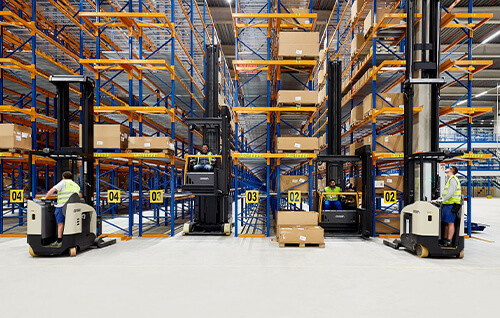
5 Questions to Consider Before Implementing New Space Planning Software
Successful businesses evaluate how, and by whom, space planning and design software will be developed, used and continuously updated.
Businesses are unique. Where one company may produce a whole source of interchangeable products to outfit an office space, another may develop the specific bearings used in a pallet racking system. Quite simply, some product lines are more complex than others.
“Companies have a lot to consider when choosing the right software,” says Brooke Snow, Global Head of Sales, Commercial & Residential Interiors at Configura. “Both the company and its end users benefit from smart software that’s outfitted to address its goals; especially the customer experience.”
Bring your products to the marketplace
Software plays a major role in how your organization can succeed in bringing products to market. If your company’s product lines aren’t easy to specify with space planning software, your products may be overlooked.
Change usually comes with a price tag. Software can be expensive and intimidating. Space planning software is not an everyday purchase. It takes ample due diligence to source the most successful space planning software for your business.

To make the right decision, a company needs to evaluate how, and by whom, the software will be developed, used and continuously updated. Software, when used incorrectly, can cause major damage. With lengthy sales and order processes and multiple tools used along the way, businesses often experience time-consuming data maintenance, lengthy updates and data entry errors.
The right software, when used correctly, will save your company time and money. Here are five questions to investigate before making a space planning software decision for your company:
| Is your company looking for an “off the shelf” solution or a custom environment? |
There are pros and cons to both, however, it is important to know what pain points the software should solve or what requirements are necessary. For example, if the software you are vetting does not support custom integrations, and that is one of your requirements, you’ll likely end up with unhappy stakeholders. But custom software can be timely and expensive. If your stakeholders are looking for a quick go-to-market solution, off-the-shelf software might be the best option.
Understanding what the software offers based on your company’s needs is critical, as well as how the software fits into your budget. Be frank and transparent from the beginning. As you dive deeper into the due diligence process, the software company you’re considering should spend time getting to know your company and products. Together you are building a level of trust and respect. If you ask questions that receive vague answers, it is time to move on and seek a better solution elsewhere.
| How complex are your products? |
The more complex your products, the more technical and agile your software needs to be. Complexity often equates to higher costs, but not always. It is critical to ensure the space planning software under review can handle your product lines. It also matters that the software company is at least somewhat familiar with your industry.
Getting too far in the process with a software company that does not understand your products or go-to-market product strategy can cost your company major dollars. Assess your products for complexity and then use that knowledge to ensure they will work successfully in the proposed software solution.
| What do you want to do with your products? |
When asking this question, also consider whether your products will be stagnant within the software or if they are meant for someone to stretch and interact with. Companies have different channels where products are sold. Channels include eCommerce, websites, sales representatives, dealerships and the like. Knowing your end users and how the software will support their needs is essential to success. If a designer is working on a whole floorplan, they likely need full functionality. If a customer is looking at a chair in an online store, a still picture or series of images might be sufficient.
Single channel and multi-channel options don’t really cut it anymore. Instead, an omnichannel approach to sales, as well as supportive, interconnected software that can do the heavy lifting, is necessary. If customer A begins their sales journey on a website, clicks over to an eCommerce platform, and then decides to go to a brick-and-mortar store instead, how your products are displayed and interacted with should remain consistent regardless of where that customer spends their time.
| Are you looking to be the best in your region or does the scope of work include expanding your market footprint to a new location(s)? |
It may seem like a no-brainer, but where you want to grow the people who specify in your products has a major influence on the space planning design software you buy. Know what you want to accomplish for your end users and customers today, as well as your 5–10 year goals.
If you’re looking to expand in a country outside of your native language, seek software that supports translation needs. The space planning software you ultimately invest in should solve immediate demands, but also support short- and long-term goal planning.
Ask what metrics are available and how data are shared and used for continuous improvement. Content is king. Regular data maintenance can increase frustration, take up valuable time and add exorbitant costs. Understanding how a space planning software supports data and where content lives will reduce these issues. Regardless of what products your company manufactures, you need a smart digital library readily available to designers and engineers.
| What type of turnaround time do you expect your staff will need to begin using the space planning software? |
Change is hard no matter what. When a company decides to change to new software, efficient time and planning are required. During the vetting process, you need to understand the typical learning curve users experience. Demo the software and assess how intuitive it is. Ask about the available training and support as part of your software purchase—remember, you aren't just buying software, you are buying Software as a Service (SaaS).
Vetting the best Software as a Service (SaaS)
In order to make the right decision, look for space planning software that goes beyond any single use. The software should allow you to create, publish, consume and reuse your data.
The right software should solve several needs. With it, you can take on more projects by decreasing design time; spend less time and money updating and maintaining product data; and, whether online or in-person, software can help designers impress customers by providing faster drawings, quotes, revisions and photo-realistic visuals.
After you investigate the questions above as they relate to your company requirements and goals, the next logical step is to request a system demo.
CET by Configura
CET is a platform of tools for companies in the commercial interior, material handling and kitchen and bath industries to create, publish and consume product data across multiple solutions. Doing so allows your company to streamline the sales and order process.
CET transforms the way spaces are designed by improving efficiencies, eliminating errors and reducing environmental waste.
subscribe to our blog
Subscribe to the Configura Blog to get notified whenever we post something new:


















